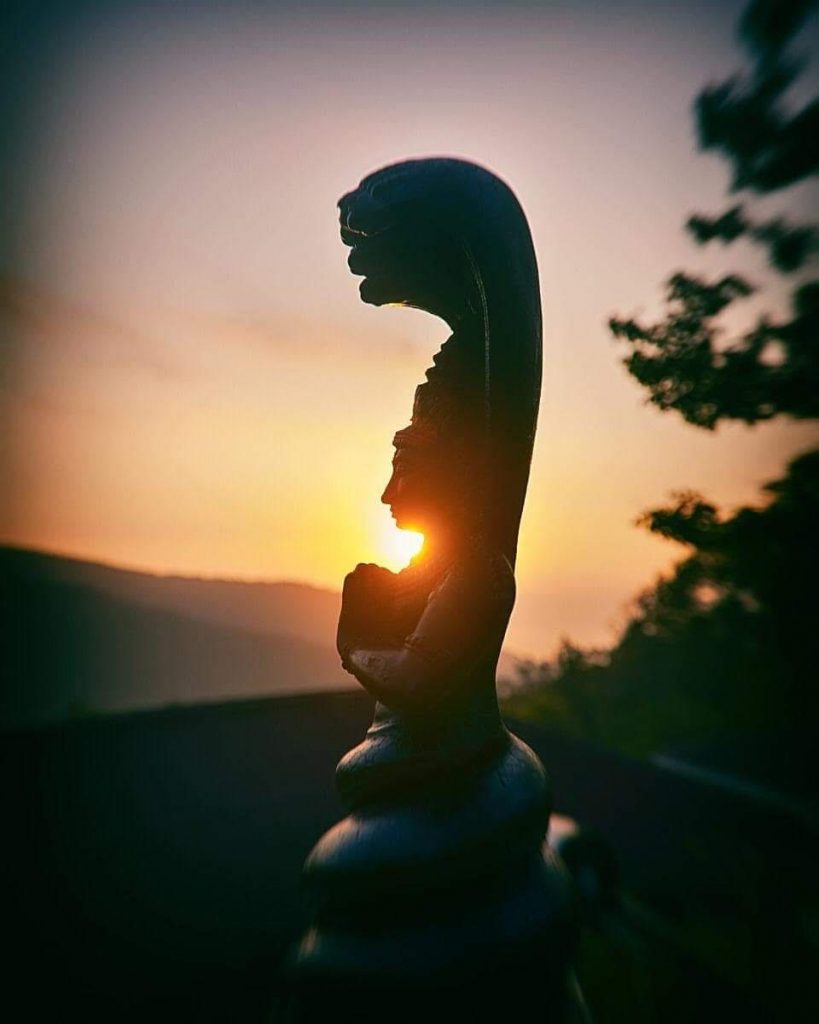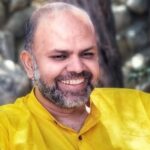
A recently concluded Yoga prayogam teacher-training course left me feeling very reflective, yet I was feeling restless wherever I went, even back home. Not because we did hours and hours of asana-prANAyAma but because we explored the sutras from chapter two, sAdhana pAda. Incidentally I had a chat with a member of my Ritambhara sangha, Sahiti, and she shared some of her intense experience after studying the chapter 2 with our teacher Raghu Ananthanarayanan. She said, “After the 4-day study session at Ritambhara ashram I felt a lot of churn at every level, where every aspect about who I was or made out to be by the world was shaken up. I felt it much more this time because my body was throwing all kinds of signals and when I went back home, my interactions with people around me was different. Different because I had dropped my own coverings or layers and yet I was in a compassionate space to look at everything including myself. It was as though I was a newborn naked baby with absolutely no covering or defenses. But I am also enjoying it because I am trying to be quiet by doing a lot of journaling, walking, Asana/prANAyAma too.” Listening to her made some of us yoga teachers want to have a chat with Raghu on the process and experience. We narrated our stories and he smiled saying “what you described is very beautiful and will happen if you take chapter 2, sAdhana pAda seriously! Though, the only issue is that since all of you are doing your sAdhana in a city space with so much noise, it may add a bit of edginess to the whole experience.” We were very curious about what he meant.
“Ok, let me explain. Chapter 2 fundamentally talks about abhiniveshaH, which is the energy of survival, the energy that drives one to live, when this important energy identifies the asmitA as the ‘self’ that has to be protected and reinforced therein lies the problem. asmitA is the idea of the self that we construct through our identifications with our experiences, the roles we play in life, the things we possess and so on. The asmitA is a defensive covering that is created in my interactions with the world, the meanings that I create about myself through the living process and it is an inevitable outcome of living in the world. The meaning making process creates ideas and conclusions about the world and oneself. It starts right from when you are a child where people around you give you meanings, your context whether family or society contributes to the entire process. This sense of self called asmitA that is created through this process is not the true Self. If you are unaware about the deeper process then this sense of self is taken for granted because it is very tangible. The second thing that is discussed in chapter 2 is rAga and dveSha i.e. craving and aversion respectively. Once you start self-reflecting, you understand the sense of self you have constructed is a defense structure or an acquisitive mechanism thanks to the rAga and dveSha that drive one’s interaction with the external world. As you start observing these tangible layers of the self-created through an awareness of the concrete and distinct world (also called as the visheSha level) start withering away and you move to a deeper avisheSha level. The avisheSha level is the energetic level of being, and one experiences the world as a deeply interconnected and seamless fabric. This dismantling of the identification with the tangible world will obviously make you feel naked and since you are operating in the world from an avisheSha level, you would be softer, more compassionate and sensitive to not only yourself but also others to understand where their feelings are emanating from. abhiniveshaH reinforces the form and structures of asmitA until you realize that this structure is false and the structure is the ultimate cause of duHkha in our lives.”
As Raghu was speaking, we looked more and more concerned initially, then felt relieved. Raghu looked right through us and said, “Well, being aware about this process is a very difficult but important step but the next tough step is when you want to dismantle these structures. You become more vulnerable and every part of your being-physical, mental and emotional becomes ultra-sensitive. This is just like a snake shedding its skin and growing a new one- a natural but sensitive process. But the problem is that we are all doing it in a city context which is very aggressive and loud.”
Sahiti immediately quips “the horns Raghu! The honking of traffic in the city became so unbearable when I went back, it was like alarm bells all around me.”
“Precisely Sahiti, your recent sensitive psyche needs a quieter space to bring out that authentic self.”
I look perplexed and ask “But Raghu, I am not a separate billiard ball because I am part of this society where I interact with people and when they continue to see me with the same armor as before then it is very frustrating.”
“Yes true, they are habituated to relating with you in a certain way and so they will continue to push for that familiar form. So, the rAga and dveSha through which they were dealing with you consciously or unconsciously will still remain in their interaction with you.”
“But what if I build the same kind of armor like before?” asked Sahiti.
“The tendency would be there but you may not build the same kind of armor and definitely not with the same rigidity as before.”
“Is it because we are more conscious?” I interrupted. Raghu nodded his head in agreement “Sahiti, you run a school and interact with children correct?” Sahiti nodded yes, “So, tell me how was the interactions with them after the study?”
“Oh, they were praising my listening skills and patience!” Raghu stood up and said “Of course, kids will pick up these changes very quickly because you are listening quietly without your defense mechanisms coming up and also learning to make choices, in a more spontaneous way.”
Raghu immediately followed it with “you also need to be careful when you handle this new self. You need to continuously withdraw into quiet spaces away from the noise and recharge yourself. This is the time when you may indulge in food or mindless consumption of TV, etc. if you are not aware. There was a time when I was very stressed after work and I would come home and watch TV for hours together not because there was an interesting program but I did not know what else to do to cut myself off from the constant internal dialogue in my mind. That is why we recommend that you do mindful things like meditation or chanting every day at a certain point of time, to give your body and mind some rest.” I nodded my head and shared that “When I do any kind of japa or chanting I feel less reactive and my cravings for certain kinds of foods or just mindless TV watching reduces.” “Ah, excellent, now you know what to do when you feel reactive or just too full-just tell people you are going to do pujA!” Raghu beamed.
I was reflecting on my own relationships and asked Raghu “If one has shifted then how does one help the world see that change?” Raghu thought for a moment and said “you cannot go and tell people that I have done a yoga class and I am a changed person. The negotiation is with you first, and until the hold of your vAsanas and samskAras are lessened, the pull of the pattern would remain. Let them struggle with how they relate to you while you are also struggling on how to relate to them. If they see some meaningful shift in you they may also adjust and recalibrate their interaction with you.”
“But they may resent these changes also?” Raghu ran his fingers through his beard and shrugged “Yes, possible. This is where negotiation with the self becomes important where your inner cravings and aversions are playing out. How you resolve this inner tension and act in a different way is the sAdhanA. You can only be in touch with and true to your new level of consciousness. This will create ripples around you like a pebble thrown in a still pond.”
Kamala, a yoga therapist and another member of our sangha asked for more clarification on this point regarding working with your own inner tensions rather than worry about the others. Raghu said “Like Sahiti mentioned, if you are also sensitive and compassionate to the other person you would not make these recalibrations a negative process. You will simply say this is who I am and not be violently oppressive about it. You will allow a change to happen without giving up your choices. Haven’t you felt something when you are in the midst of an evolved person? If I am not holding anger towards the world around me and the other evolved person comes in front of a few of us then all our defense mechanisms will also drop. This is what the sutra ahimsA pratiShThAyAm tat-sannidhau vaira-tyAgaH is saying.”
At this point Sahiti excitedly tells us how it has been simpler and less stressful interacting with people as she progressed with her sAdhana. “I have found a new bhUmi for myself without fighting for it.” She exclaims. Raghu smiles like a satisfied teacher of a student who finally gets it! “If you look at yourself as a separate billiard ball entity, you will be confused. Instead you need to understand who you are in relation with other things in the world, that is when you are operating from an avisheSha level.”
Kamala then asked “But many times as a teacher your own rAga and dveSha comes up as you are listening to a student. How does one hold the space then?” Raghu, without much hesitation said “Simple, do not pretend to be the person who does not have any rAga and dveSha. Just share with the person what is it that you are experiencing because that is where you are.” We all smile but still look a bit unclear. Raghu did not need any more cues and explained “See, you react or interact with the world from your structures of rAga and dveSha. Below these structures is a sense of self created by avidyA. Which is powered by abhinivesha. None of these structures i.e. asmitA, avidyA and abhinivesha are visible to you except during fight or flight situations when your abhinivesha comes into play or rather it is only a manifestation of abhinivesha. The second chapter of yoga sutra explains how you experience this structure. te hlAda paritApa phalAH punya apunya hetutvAt if you try and understand this sutra it is saying that my experience in the world outside, pleasant or unpleasant comes from a deeper space. In experiential terms, it means that if I step back and ask where is my reaction coming from? You can start to realize the nature of asmitA and the energy of abinivesha. Remember you need to quietly observe without judging or reprimanding yourself because you need to only understand the structure of your mind. Just doing this will dissolve the structures. If you do this observation with a fair amount of intensity it will be easier to dissolve these structures.”
There was a thoughtful silence after Raghu explained this, Sahiti broke the silence by asking “So, during the entire sadhanA are you vulnerable or are you raw?” Raghu answered “when you drop your structures, you will feel raw and it can make you very reactive unless you learn how to be quiet.” Sahiti sheepishly admitted “Yes, like how I reacted so many times after an intense program at Ritambhara.” Raghu supportively said “you just learn to observe and the healing will happen. In certain contexts, the mind has intelligently created multiple defenses, and escape mechanisms covering a much deeper svabhAva. If you are conscious and self-reflective, you will touch that depth.”
Priya, another yoga therapist explained, “I have my gifts and due to these defense structures, I am unable to use these gifts productively. For e.g. an artist who has a brilliant imagination may only day dream which is an escape mechanism. But if he/she is conscious about it then this person can truly become creative with these gifts and do something beautiful, thus artistry is the svabhAva. Am I correct in my understanding Raghu?”
Raghu quietly nodded. “Then what is vulnerability?” asked Sahiti. “That is when your defenses are down and you are in a space of shAntam or quietness. The problem I see is that people use these terms loosely causing confusion. It is difficult to experience vulnerability- One is extremely sensitive and yet not defensive at all. This space is very intense in my opinion.”
Sahiti had a flash of understanding and explained, “Ok, I think I understand. When I feel raw, I surely do not sense a space of shAntam. Thus, if I am aware about this phase I must retreat and quieten myself, else I will again build new defense mechanisms.” “Yes, because the psyche will immediately act to protect itself. I also have a feeling that is why in the Buddhist thought they say every now and then you should take three quiet breaths. My teacher Krishnamacharya also said that in the morning after a few hours of work instead of having a cup of tea or coffee stop and do some meditation. This would actually help you lose weight because your metabolism settles. If you feel agitated, your body has produced toxins which would lead to cravings for foods high in sugar and salt.” Priya agreed and added “isn’t this how food companies trick you into buying their foods?” Raghu agreed “Of course, there have been many researches to prove that a salt, sugar and fat mix is something that your body craves when it has a high amount of toxins. The food companies have figured out this ratio and use it really well.”Kamala added “No wonder, people put on weight when they react or get stressed out.” “It is quite simple guys, if you do not have an Asana/prANAyAma practice you do not know how to settle your body once the chemical reactions have taken place. Today we are constantly bombarded with ‘breaking news’ or some loud noise to grab our attention and make our alarm bells ring. It will provoke attraction or repulsion, both of which agitate your system and create toxins. Thus, making you crave for something like alcohol, cigarettes or food. Yoga is the complete opposite of this.” Said Raghu clearly.
I asked “Apart from food and an Asana/prANAyAma practice, what else would help us when we are in this state?” Again, Raghu answered referring to the Yoga Sutra “yama-niyama is always there to guide you. Also make sure the spaces you enter do not trigger something violent in you, it is better to be in a context, which helps you be reflective and quiet. yama and niyama create a space for you to move inwards through dhAraNA and then dhyAnA.”
The conversation ended with satisfied comments and a feeling of inner quietness. It seemed like a complete circle when Raghu talked about ashtanga yoga and this is exactly what the 2nd chapter of yoga sutra talks about. It takes a lifetime to practice the 2nd chapter- sAdhanA pAda and our group made a small effort to start talking and walking the path.


 Anoop is a student of Yoga, an entrepreneur, a coach and a father of two young boys. He has led successful leadership stints in both the corporate and non-for-profit sectors. On encountering the country’s water/farmer crises at close quarters, he decided to pause and examine the impact various ‘isms’ – capitalism, colonialism, etc., were having on us as individuals, families, the society and the environment at large. This quest led him to formally engage with traditional Indic knowledge systems while also learning from the latest advances in science – about our physical and mental wellbeing, importance of body and mind work in healing trauma and the urgent need for a conscious rebuilding of family / work / social structures if we have to thrive individually and collectively. Insights, frameworks and processes gleaned from these on-going studies, an anchorage in his own personal practice and his wide-ranging experiences is what Anoop brings to facilitation/coaching spaces in Ritambhara and his various professional engagements.
Anoop is a student of Yoga, an entrepreneur, a coach and a father of two young boys. He has led successful leadership stints in both the corporate and non-for-profit sectors. On encountering the country’s water/farmer crises at close quarters, he decided to pause and examine the impact various ‘isms’ – capitalism, colonialism, etc., were having on us as individuals, families, the society and the environment at large. This quest led him to formally engage with traditional Indic knowledge systems while also learning from the latest advances in science – about our physical and mental wellbeing, importance of body and mind work in healing trauma and the urgent need for a conscious rebuilding of family / work / social structures if we have to thrive individually and collectively. Insights, frameworks and processes gleaned from these on-going studies, an anchorage in his own personal practice and his wide-ranging experiences is what Anoop brings to facilitation/coaching spaces in Ritambhara and his various professional engagements.
 Priya is a Yoga therapist in the Krishnamacharya tradition. She adapts Reiki & energy work, Vedic chanting, life coaching & Ayurvedic practices in her healing spaces. She is committed to nurturing collectives that have the praxis of Yoga at their heart.
Priya is a Yoga therapist in the Krishnamacharya tradition. She adapts Reiki & energy work, Vedic chanting, life coaching & Ayurvedic practices in her healing spaces. She is committed to nurturing collectives that have the praxis of Yoga at their heart. Anisha has been on an exploration to understand herself through yoga for the last 15years which led her to teaching yoga, yoga therapy and inner work through yoga.
Anisha has been on an exploration to understand herself through yoga for the last 15years which led her to teaching yoga, yoga therapy and inner work through yoga. Apoorva chanced upon Yoga in her early 20s. A spark was lit within and there was no turning back. Her exploration led her to the Krishnamacharya tradition more than a decade ago. Curious about human behaviour and what drives it, she was thrilled when her search ended (and also began) when she first came upon the Yoga Sutra, which illuminated a path towards answering many questions that had been held for a long time.
Apoorva chanced upon Yoga in her early 20s. A spark was lit within and there was no turning back. Her exploration led her to the Krishnamacharya tradition more than a decade ago. Curious about human behaviour and what drives it, she was thrilled when her search ended (and also began) when she first came upon the Yoga Sutra, which illuminated a path towards answering many questions that had been held for a long time. Anita is a yoga teacher and therapist in the tradition of Sri.T.Krishnamacarya and Sri T.K.V. Desikachar, a Reiki practitioner and a Life Coach. She is also the founder of Vishoka, a center for learning Indic and energy-based frameworks for living and healing. Her deep concern for human suffering and the problems of unsustainable living kept her on the path of seeking an integrated approach to looking at life, living, learning and healing.
Anita is a yoga teacher and therapist in the tradition of Sri.T.Krishnamacarya and Sri T.K.V. Desikachar, a Reiki practitioner and a Life Coach. She is also the founder of Vishoka, a center for learning Indic and energy-based frameworks for living and healing. Her deep concern for human suffering and the problems of unsustainable living kept her on the path of seeking an integrated approach to looking at life, living, learning and healing. Ankit is a seeker in the wisdom traditions of India. The core of his work includes creating dialogic spaces where people can look within and see the connection between their inner and outer lives. Inspired by the likes of Gandhi, Aurobindo, Vivekananda and Guru Gobind his experiments in service took him back to his roots in Punjab where he is creating a community-led model of higher education which is open, inclusive and accessible for all. Ritambhara for him is a space for engaging in a community which is committed to a DHramic life. He anchors his work of learning and leadership in the Antaranga Yoga Sadhana and the humanistic wisdom of Mahabharata.
Ankit is a seeker in the wisdom traditions of India. The core of his work includes creating dialogic spaces where people can look within and see the connection between their inner and outer lives. Inspired by the likes of Gandhi, Aurobindo, Vivekananda and Guru Gobind his experiments in service took him back to his roots in Punjab where he is creating a community-led model of higher education which is open, inclusive and accessible for all. Ritambhara for him is a space for engaging in a community which is committed to a DHramic life. He anchors his work of learning and leadership in the Antaranga Yoga Sadhana and the humanistic wisdom of Mahabharata.